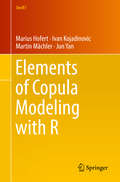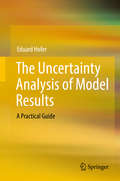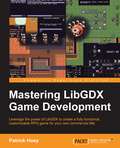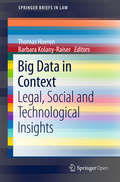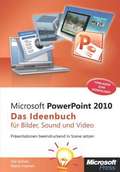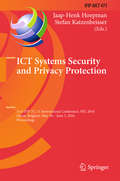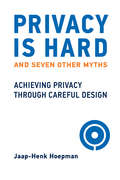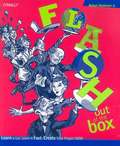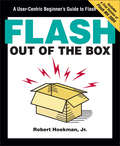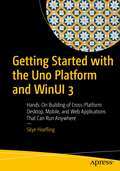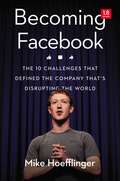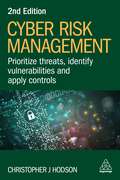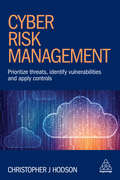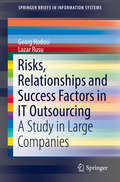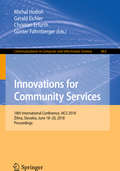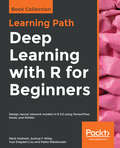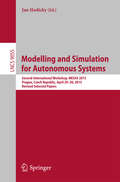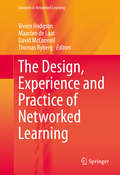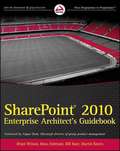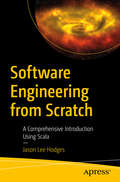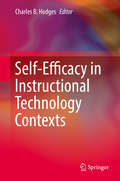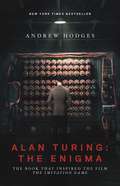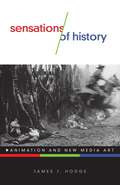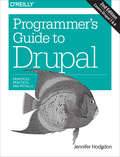- Table View
- List View
Elements of Copula Modeling with R (Use R!)
by Marius Hofert Ivan Kojadinovic Martin Mächler Jun YanThis book introduces the main theoretical findings related to copulas and shows how statistical modeling of multivariate continuous distributions using copulas can be carried out in the R statistical environment with the package copula (among others). Copulas are multivariate distribution functions with standard uniform univariate margins. They are increasingly applied to modeling dependence among random variables in fields such as risk management, actuarial science, insurance, finance, engineering, hydrology, climatology, and meteorology, to name a few. In the spirit of the Use R! series, each chapter combines key theoretical definitions or results with illustrations in R. Aimed at statisticians, actuaries, risk managers, engineers and environmental scientists wanting to learn about the theory and practice of copula modeling using R without an overwhelming amount of mathematics, the book can also be used for teaching a course on copula modeling.
The Uncertainty Analysis of Model Results: A Practical Guide
by Eduard HoferThis book is a practical guide to the uncertainty analysis of computer model applications. Used in many areas, such as engineering, ecology and economics, computer models are subject to various uncertainties at the level of model formulations, parameter values and input data. Naturally, it would be advantageous to know the combined effect of these uncertainties on the model results as well as whether the state of knowledge should be improved in order to reduce the uncertainty of the results most effectively. The book supports decision-makers, model developers and users in their argumentation for an uncertainty analysis and assists them in the interpretation of the analysis results.
Mastering LibGDX Game Development
by Patrick HoeyLeverage the power of LibGDX to create a fully functional, customizable RPG game for your own commercial title About This Book * Learn game architecture and design patterns with concrete examples using proper software engineering principles * Save time and money with this handy reference guide for future game development with LibGDX * Design and develop a fully functional RPG video game from scratch with a hands on, step-by-step approach using LibGDX Who This Book Is For If you are an intermediate-level game developer who wants to create an RPG video game but found the creation process overwhelming, either by lack of tutorials or by getting lost in a sea of game-related technologies, engines, or frameworks, then this book is for you. This book assumes familiarity with Java and some basic knowledge of LibGDX. What You Will Learn * Develop characters with stat attributes, player movement, animation, physics, and collision detection * Create interactive NPC characters with speech windows and build immersion via dialog trees * Build inventory management system UIs with drag and drop items to sell, buy, and equip * Design a quest system to expand out the content of your game * Form interesting enemies with battle mechanics and spawn points * Devise scripted cutscenes to add an element of story and drama * Develop save and load game profiles * Create special effects to give the game extra "juiciness" and polish, and help build the atmosphere In Detail LibGDX is a Java-based framework developed with a heavy emphasis on performance, and includes cross-platform support out of the box (Windows, OS X, Linux, iOS, Android, and HTML5) as well as providing all the low-level functionality so that you can focus on developing your game and not battling with the platform. LibGDX also has an engaged and responsive community, active maintenance, and is available for free without a prohibitive license. Starting from the beginning, this book will take you through the entire development process of creating an RPG video game using LibGDX. First, this book will introduce you to the features specific to RPG games, as well as an overview of game architecture. Then, you will create map locations, develop character movement, add animation, integrate collision detection, and develop a portal system. Next, you will learn and develop a HUD and other UI components, as well as an inventory management system. You will then develop NPC interactions including dialog trees, shopkeepers, and quest givers. After this, you will design and create battle features for fighting enemies, as well as event triggers for world events. Finally, you will add the final polish with sound, music, and lighting effects. By the end of this book, you will have learned and applied core components from the LibGDX framework, as well as have a finished game to use as a springboard for customization and story development for your own commercial video game. Style and approach This book walks you through the concepts and implementation of developing a complete RPG game, unfolding chapter by chapter and building upon previous concepts. Each chapter can be used as an individual reference with diagrams to explain core concepts with concrete example code explained in detail.
Big Data in Context: Legal, Social and Technological Insights (SpringerBriefs in Law)
by Thomas Hoeren Barbara Kolany-RaiserThis book is open access under a CC BY 4. 0 license. This book sheds new light on a selection of big data scenarios from an interdisciplinary perspective. It features legal, sociological and economic approaches to fundamental big data topics such as privacy, data quality and the ECJ's Safe Harbor decision on the one hand, and practical applications such as smart cars, wearables and web tracking on the other. Addressing the interests of researchers and practitioners alike, it provides a comprehensive overview of and introduction to the emerging challenges regarding big data. All contributions are based on papers submitted in connection with ABIDA (Assessing Big Data), an interdisciplinary research project exploring the societal aspects of big data and funded by the German Federal Ministry of Education and Research. This volume was produced as a part of the ABIDA project (Assessing Big Data, 01IS15016A-F). ABIDA is a four-year collaborative project funded by the Federal Ministry of Education and Research. However the views and opinions expressed in this book reflect only the authors' point of view and not necessarily those of all members of the ABIDA project or the Federal Ministry of Education and Research.
Microsoft PowerPoint 2010 - Das Ideenbuch für Bilder, Sound und Video
by Maria Hoeren Ute SimonEin Bild sagt mehr als 1.000 Worte - noch beeindruckender sind Videos! Begeistern Sie Ihr Publikum mit den erweiterten Multimediafunktionen in PowerPoint 2010. Ob Messeauftritt, Präsentation beim Kunden, multimediale Produktvorstellung oder selbstablaufende Informationsvideos - dieses Buch zeigt Ihnen anhand zahlreicher Praxisbeispiele, wie Sie Ihre Präsentationen durch Bilder, Sound und Video aufwerten. Alle Beispiele sind als Download verfügbar und können sofort in Ihren Präsentationen verwendet werden.
ICT Systems Security and Privacy Protection
by Jaap-Henk Hoepman Stefan KatzenbeisserThis book constitutes the refereed proceedings of the 31st IFIP TC 11 International Conference on ICT Systems Security and Privacy Protection, SEC 2016, held in Ghent, Belgium, in May/June 2016. The 27 revised full papers presented were carefully reviewed and selected from 139 submissions. The papers are organized in topical sections on cryptographic protocols, human aspects of security, cyber infrastructure, social networks, software vulnerabilities, TPM and internet of things, sidechannel analysis, software security, and privacy.
Privacy Is Hard and Seven Other Myths: Achieving Privacy through Careful Design
by Jaap-Henk HoepmanAn expert on computer privacy and security shows how we can build privacy into the design of systems from the start.We are tethered to our devices all day, every day, leaving data trails of our searches, posts, clicks, and communications. Meanwhile, governments and businesses collect our data and use it to monitor us without our knowledge. So we have resigned ourselves to the belief that privacy is hard--choosing to believe that websites do not share our information, for example, and declaring that we have nothing to hide anyway. In this informative and illuminating book, a computer privacy and security expert argues that privacy is not that hard if we build it into the design of systems from the start. Along the way, Jaap-Henk Hoepman debunks eight persistent myths surrounding computer privacy. The website that claims it doesn't collect personal data, for example; Hoepman explains that most data is personal, capturing location, preferences, and other information. You don't have anything to hide? There's nothing wrong with wanting to keep personal information--even if it's not incriminating or embarrassing--private. Hoepman shows that just as technology can be used to invade our privacy, it can be used to protect it, when we apply privacy by design. Hoepman suggests technical fixes, discussing pseudonyms, leaky design, encryption, metadata, and the benefits of keeping your data local (on your own device only), and outlines privacy design strategies that system designers can apply now.
Flash out Of the Box
by Robert HoekmanIf you believe the sky really is the limit when it comes to creating unparalleled user experiences and applications for the Web--then Macromedia Flash MX is sure to be your tool of choice. With Flash, you can integrate video, text, audio, and graphics into distinctive and compelling web content, stunningly interactive and expressive user interfaces, and rich applications for the Internet. Flash is all about helping you dramatically enhance the user experience. And Flash Out of the Box is all about helping you think outside of the box to get there--first, by diving into the Flash box and then becoming intimately acquainted with every nook and cranny of it. In Flash Out of the Box , you'll follow and work with a simple box through a "day in the life" style journey. You'll study, use, abuse, and transform the box as you move through exercises that teach you the basics of Flash, and much more, in an entertaining, unforgettable, task-oriented fashion. You'll learn to animate, work with video, load external assets, draw, mask, modularize, and many other things that will be essential as you move into more advanced techniques with other books. It's just you, Flash, and the box, mastering each technique along the way and adding others in a fashion that will let you practice and learn simultaneously. Most Flash tutorials you've looked at are tool-centric, focusing on Flash's individual features and how to use them (an approach that can quickly become tedious), whereas this innovative, engaging, and motivating book is uniquely user-centric. That means it concentrates on you and what you want and need to learn. Each successive lesson anticipates and builds upon your needs, capabilities, and questions as you evolve from Flash beginner to Flash master. Written in a fun and conversational tone, the highly accessible Flash Out of the Box makes learning Flash MX 2004 intuitive, logical, and, most of all, fun.
Flash Out of the Box
by Robert Hoekman Jr.If you believe the sky really is the limit when it comes to creating unparalleled user experiences and applications for the Web--then Macromedia Flash MX is sure to be your tool of choice. With Flash, you can integrate video, text, audio, and graphics into distinctive and compelling web content, stunningly interactive and expressive user interfaces, and rich applications for the Internet. Flash is all about helping you dramatically enhance the user experience. And Flash Out of the Box is all about helping you think outside of the box to get there--first, by diving into the Flash box and then becoming intimately acquainted with every nook and cranny of it. In Flash Out of the Box, you'll follow and work with a simple box through a "day in the life" style journey. You'll study, use, abuse, and transform the box as you move through exercises that teach you the basics of Flash, and much more, in an entertaining, unforgettable, task-oriented fashion. You'll learn to animate, work with video, load external assets, draw, mask, modularize, and many other things that will be essential as you move into more advanced techniques with other books. It's just you, Flash, and the box, mastering each technique along the way and adding others in a fashion that will let you practice and learn simultaneously. Most Flash tutorials you've looked at are tool-centric, focusing on Flash's individual features and how to use them (an approach that can quickly become tedious), whereas this innovative, engaging, and motivating book is uniquely user-centric. That means it concentrates on you and what you want and need to learn. Each successive lesson anticipates and builds upon your needs, capabilities, and questions as you evolve from Flash beginner to Flash master. Written in a fun and conversational tone, the highly accessible Flash Out of the Box makes learning Flash MX 2004 intuitive, logical, and, most of all, fun.
Getting Started with the Uno Platform and WinUI 3: Hands-On Building of Cross-Platform Desktop, Mobile, and Web Applications That Can Run Anywhere
by Skye HoeflingGet ready to build applications that can run anywhere using the Uno Platform and WinUI.Modern application development can be an intimidating and complex topic, especially when you are building cross-platform applications that need to support multiple operating systems and form factors. There are so many options when it comes to frameworks and selecting the right one for your enterprise is critical in delivering a successful product to market. For the developer who has zero experience building apps with Xamarin, UWP, WinUI, or the Uno Platform, this book deconstructs those complex concepts into tangible building blocks so that productivity gains are immediately recognized.You will start off learning basic concepts and get a bird's-eye view of the enabling technologies to ensure that you feel comfortable with the tools and terminology. From there, you will learn about some of the more popular options in the .NET ecosystem, understand their attributes and shortcomings, and learn why the Uno Platform is ideal for building a cross-platform application that targets Android, iOS, Windows, WASM (Web Assembly), Linux, and MacOS. Then, you will follow a product release timeline that takes you through building an application, introducing key concepts at every step of the way. Each section of the book is chock full of tips and edge case documentations for the different platforms.What You Will Learn Manage multi-targeting solutions: specifically, how to handle the different project headsEffectively write cross-platform software and handle the edge cases of the different platformsUnderstand the fundamentals of working with Uno Platform WinUI appsExplore enterprise-grade application architecture using MVVMUnderstand Dependency Injection and how it applies to application architecture Who This Book Is ForDevelopers who understand some basics of C# and object-oriented programming
Becoming Facebook: The 10 Challenges That Defined the Company that's Disrupting the World
by Mike HoefflingerFacebook’s founding is legend: In a Harvard dorm, wunderkind Mark Zuckerberg invented a new way to connect with friends…and the rest is history. But for the people who actually molded this great idea into a game-changing $300 billion company, the experience was far more tumultuous and uncertain than we might expect.Mike Hoefflinger was one of those Facebook insiders. As a computer engineer turned marketing innovator who worked with COO Sheryl Sandberg, Hoefflinger had a front-row seat to the company’s growing pains, stumbles, and reinventions.Becoming Facebook tells the coming-of-age story of the now venerable giant. Filled with insights and anecdotes from crises averted and challenges solved, the book tracks the company’s development, uncovering lessons learned on its way to greatness:How Facebook recovered from its “disastrous” IPO How the growth team achieved the impossible Why Facebook’s News Feed ads were the company’s most important business decision ever How Google+ attacked and lost Why—and how—Instagram and WhatsApp were added to the mix What the company does to win the talent wars What makes Zuckerberg, Sandberg, Cox, and other A-teamers tick Which products and technical advancements are on the horizon and why And much moreIntimate, fast-paced, and deeply informative, Becoming Facebook shares the true story of how Zuckerberg joined the ranks of iconic CEOs like Steve Jobs, Larry Page, and Jeff Bezos—as Facebook grows up, overcomes setbacks, and works to connect the world.
Cyber Risk Management: Prioritize Threats, Identify Vulnerabilities and Apply Controls
by Christopher J HodsonHow can you manage the complex threats that can cause financial, operational and reputational damage to the business? This practical guide shows how to implement a successful cyber security programme. The second edition of Cyber Risk Management covers the latest developments in cyber security for those responsible for managing threat events, vulnerabilities and controls. These include the impact of Web3 and the metaverse on cyber security, supply-chain security in the gig economy and exploration of the global, macroeconomic conditions that affect strategies. It explains how COVID-19 and remote working changed the cybersecurity landscape.Cyber Risk Management presents a data-centric approach to cyber risk management based on business impact assessments, data classification, data flow modelling and assessing return on investment. It covers pressing developments in artificial intelligence, machine learning, big data and cloud mobility, and includes advice on dealing with malware, data leakage, insider threat and Denial-of-Service. With analysis on the innate human factors affecting cyber risk and awareness and the importance of communicating security effectively, this book is essential reading for all risk and cybersecurity professionals.
Cyber Risk Management: Prioritize Threats, Identify Vulnerabilities and Apply Controls
by Christopher HodsonMost organizations are undergoing a digital transformation of some sort and are looking to embrace innovative technology, but new ways of doing business inevitably lead to new threats which can cause irreparable financial, operational and reputational damage. In an increasingly punitive regulatory climate, organizations are also under pressure to be more accountable and compliant. Cyber Risk Management clearly explains the importance of implementing a cyber security strategy and provides practical guidance for those responsible for managing threat events, vulnerabilities and controls, including malware, data leakage, insider threat and Denial-of-Service. Examples and use cases including Yahoo, Facebook and TalkTalk, add context throughout and emphasize the importance of communicating security and risk effectively, while implementation review checklists bring together key points at the end of each chapter. Cyber Risk Management analyzes the innate human factors around risk and how they affect cyber awareness and employee training, along with the need to assess the risks posed by third parties. Including an introduction to threat modelling, this book presents a data-centric approach to cyber risk management based on business impact assessments, data classification, data flow modelling and assessing return on investment. It covers pressing developments in artificial intelligence, machine learning, big data and cloud mobility, and includes advice on responding to risks which are applicable for the environment and not just based on media sensationalism.
Risks, Relationships and Success Factors in IT Outsourcing: A Study in Large Companies (SpringerBriefs in Information Systems)
by Georg Hodosi Lazar RusuThis book addresses the buying organizations' perspective on risks, relationships and success factors for accomplishing a successful IT Outsourcing (ITO). Today’s landscape in ITO is complex and these perspectives are important in ITO and therefore there is still a need for it to be further explored. Furthermore the studies concerned the risks, relationships and success factors in ITO need to be extended in more large companies from different countries to better understand how we could improve the ITO in these companies. In order to address this issue the authors of this book have performed different studies that span about 10 years concerning the risks, relationships and success factors in ITO in large companies in Sweden. The authors have focused on both theoretical and practical aspects concerning risks, relationships and success factors in ITO and they have used transaction cost theory, agency theory and core competency theory as main theories to support their research. The data concerning this study has been collected at two different times during the last 10 years with about five years' difference between them. In this way the performed research has enabled a comparison of the data collected on two different periods in time including of the related changes. The book will help researchers in ITO as well as practitioners like ITO decision makers in large companies to understand how to mitigate the ITO risks, improve their ITO relationships and identify the ITO success factors.
Innovations for Community Services: 18th International Conference, I4CS 2018, Žilina, Slovakia, June 18-20, 2018, Proceedings (Communications in Computer and Information Science #863)
by Michal Hodoň Gerald Eichler Christian Erfurth Günter FahrnbergerThis book constitutes the refereed proceedings of the 18th International Conference on Innovations for Community Services, I4CS 2018, held in Žilina, Slovakia, in June 2018.The 14 revised full papers and the three revised short papers presented in this volume were carefully reviewed and selected from 38 submissions. The papers are organized in topical sections on architectures and management; data analytics and models; community and public collaboration; innovations and digital transformation.
Deep Learning with R for Beginners: Design neural network models in R 3.5 using TensorFlow, Keras, and MXNet
by Mark Hodnett Joshua F. Wiley Yuxi (Hayden) Liu Pablo MaldonadoExplore the world of neural networks by building powerful deep learning models using the R ecosystemKey FeaturesGet to grips with the fundamentals of deep learning and neural networksUse R 3.5 and its libraries and APIs to build deep learning models for computer vision and text processingImplement effective deep learning systems in R with the help of end-to-end projectsBook DescriptionDeep learning finds practical applications in several domains, while R is the preferred language for designing and deploying deep learning models.This Learning Path introduces you to the basics of deep learning and even teaches you to build a neural network model from scratch. As you make your way through the chapters, you’ll explore deep learning libraries and understand how to create deep learning models for a variety of challenges, right from anomaly detection to recommendation systems. The book will then help you cover advanced topics, such as generative adversarial networks (GANs), transfer learning, and large-scale deep learning in the cloud, in addition to model optimization, overfitting, and data augmentation. Through real-world projects, you’ll also get up to speed with training convolutional neural networks (CNNs), recurrent neural networks (RNNs), and long short-term memory networks (LSTMs) in R.By the end of this Learning Path, you’ll be well versed with deep learning and have the skills you need to implement a number of deep learning concepts in your research work or projects.This Learning Path includes content from the following Packt products:R Deep Learning Essentials - Second Edition by Joshua F. Wiley and Mark HodnettR Deep Learning Projects by Yuxi (Hayden) Liu and Pablo MaldonadoWhat you will learnImplement credit card fraud detection with autoencodersTrain neural networks to perform handwritten digit recognition using MXNetReconstruct images using variational autoencodersExplore the applications of autoencoder neural networks in clustering and dimensionality reductionCreate natural language processing (NLP) models using Keras and TensorFlow in RPrevent models from overfitting the data to improve generalizabilityBuild shallow neural network prediction modelsWho this book is forThis Learning Path is for aspiring data scientists, data analysts, machine learning developers, and deep learning enthusiasts who are well versed in machine learning concepts and are looking to explore the deep learning paradigm using R. A fundamental understanding of R programming and familiarity with the basic concepts of deep learning are necessary to get the most out of this Learning Path.
Modelling and Simulation for Autonomous Systems
by Jan HodickyThis book constitutes the thoroughly refereed post-workshop proceedings of the Second International Workshop on Modelling and Simulation for Autonomous Systems, MESAS 2015, held in Prague, Czech Republic, in April 2015. The 18 revised full papers included in the volume were carefully reviewed and selected from 33 submissions. They are organized in the following topical sections: state of the art and future of AS; MS experimental frameworks for AS; methods and algorithms for AS.
The Design, Experience and Practice of Networked Learning
by Vivien Hodgson Maarten De Laat David Mcconnell Thomas RybergThe Design, Experience and Practice of Networked Learning Edited by: Vivien Hodgson, Maarten de Laat, David McConnell and Thomas Ryberg This book brings together a wealth of new research that opens up the meaning of connectivity as embodied and promised in the term ''networked learning''. Chapters explore how contexts, groups and environments can be connected rather than just learners; how messy, unexpected and emergent connections can be made rather than structured and predefined ones; and how technology connects us to learning and each other, but also shapes our identity. These exciting new perspectives ask us to look again at what we are connecting and to revel in new and emergent possibilities arising from the interplay of social actors, contexts, technologies, and learning. Caroline Haythornthwaite, University of British Columbia Despite creating fundamentally new educational economics and greatly increasing access - teaching and learning in networks is a tricky business. These chapters illuminate the complex interactions amongst tools, pedagogy, educational institutions and personal net presences - helping us design and redesign our own networks. In the process, they take (or extract) network theory from the practice of real teaching and learning contexts, making this collection an important contribution to Networked Learning. Terry Anderson, Athabasca University What kinds of learning can social networking platforms really enable? Digging well beneath the hype, this book provides a timely, incisive analysis of why and how learning emerges (or fails to) in networked spaces. The editors do a fine job in guiding the reader through the rich array of theories and methods for tackling this question, and the diverse contexts in which networked learning is now being studied. This is a book for reflective practitioners as well as academics: the book''s close attention to the political, pedagogical and organisational complexity of effective practice, and the lived experience of educators and learners, helps explain why networked learning has such disruptive potential -- but equally, why it draws resistance from the establishment. Simon Buckingham Shum, The Open University The networked learning conference, a biannual institution since 1998, celebrates its 14th year in this volume. Here a range of studies, reflecting networked learning experiments across Europe and other global contexts , show important shifts away from a conservative tradition of OEe-learning¹ research and unpeel dilemmas of promoting learning as an elusive practice in virtual environments. The authors point towards important futures in online learning research, where notions of knowledge, connectivity and OEcommunity¹ become increasingly elastic, and engagements slide across material and virtual domains in new practices whose emergence is increasingly difficult to apprehend. Tara Fenwick - University of Stirling. The chapters in this volume explore new and innovative ways of thinking about the nature of networked learning and its pedagogical values and beliefs. They pose a challenge to us to reflect on what we thought networked learning was 15 year ago, where it is today and where it is likely to be headed. Each chapter brings a particular perspective to the themes of design, experience and practice of networked learning, the chosen focus of the book. The chapters in the book embrace a wide field of educational areas including those of higher education, informal learning, work-based learning, continuing professional development, academic staff development, and management learning. The Design, Experience and Practice of Networked Learning will prove indispensable reading for researchers, teachers, consultants, and instructional designers in higher and continuing education; for those involved in staff and educational development, and for those studying post graduate qualifications in learning and teaching. This, the second volume in the Springer Book Series on Researching Networked Learning, is based on a selection of papers presented a...
SharePoint 2010 Enterprise Architect's Guidebook
by Neil Hodgkinson Martin Kearn Paul Olenick Natalya Voskresenskaya Huge Esperanca Matt Ranlett Simon Walker Vesa Juvonen Ian Morrish Brian Wilson Chris Gideon Bill Baer Chris Whitehead Nigel Bridport Sam Hassani Jim Adams Arpan Shah Scott Kleven Reza AlirezaeiTips and techniques for becoming a successful SharePoint architectIf you're eager to design and architect a successful deployment of SharePoint 2010, then this is the book for you. Packed with real-world experiences and solid processes, this guidebook provides you with everything you need to perform for designing and architecting enterprise portal services. Helpful examples examine the common design issues affecting SharePoint 2010 environments that can cause deployments to fail so you can learn what to avoid. Plus, key development and deployment issues are covered from an architecture perspective and backup and disaster recovery planning are described at length.Details the skills and attributes necessary in order to design and architect successful SharePoint 2010 deploymentsProvides real-world scenarios and helpful examples of various types of enterprise portal servicesDiscusses corporate Intranet service, enterprise content management, team collaboration services, enterprise search service, and moreAddresses marketing your SharePoint 2010 solution to users to ensure they are aware of the services you provideWith SharePoint 2010 Enterprise Architect's Guidebook, you'll quickly discover the requirements for designing a successful SharePoint 2010 deployment.
Software Engineering from Scratch: A Comprehensive Introduction Using Scala
by Jason Lee HodgesLearn software engineering from scratch, from installing and setting up your development environment, to navigating a terminal and building a model command line operating system, all using the Scala programming language as a medium. The demand for software engineers is growing exponentially, and with this book you can start your journey into this rewarding industry, even with no prior programming experience.Using Scala, a language known to contain “everything and the kitchen sink,” you’ll begin coding on a gentle learning curve by applying the basics of programming such as expressions, control flow, functions, and classes. You’ll then move on to an overview of all the major programming paradigms. You’ll finish by studying software engineering concepts such as testing and scalability, data structures, algorithm design and analysis, and basic design patterns. With Software Engineering from Scratch as your navigator, you can get up to speed on the software engineering industry, develop a solid foundation of many of its core concepts, and develop an understanding of where to invest your time next. What You Will LearnUse Scala, even with no prior knowledgeDemonstrate general Scala programming concepts and patternsBegin thinking like a software engineerWork on every level of the software development cycleWho This Book Is ForAnyone who wants to learn about software engineering; no prior programming experience required.
Self-Efficacy in Instructional Technology Contexts
by Charles B. HodgesThis edited volume contains reports of current research, and literature reviews of research, involving self-efficacy in various instructional technology contexts. The chapters represent international perspectives across the broad areas of K- 12 education, higher education, teacher self-efficacy, and learner self-efficacy to capture a diverse cross section of research on these topics. The book includes reviews of existing literature and reports of new research, thus creating a comprehensive resource for researchers and designers interested in this general topic. The book is especially relevant to students and researchers in educational technology, instructional technology, instructional design, learning sciences, and educational psychology.
Alan Turing: The Book That Inspired the Film The Imitation Game - Updated Edition
by Andrew HodgesA NEW YORK TIMES BESTSELLERThe official book behind the Academy Award-winning film The Imitation Game, starring Benedict Cumberbatch and Keira KnightleyIt is only a slight exaggeration to say that the British mathematician Alan Turing (1912–1954) saved the Allies from the Nazis, invented the computer and artificial intelligence, and anticipated gay liberation by decades—all before his suicide at age forty-one. This New York Times bestselling biography of the founder of computer science, with a new preface by the author that addresses Turing&’s royal pardon in 2013, is the definitive account of an extraordinary mind and life.Capturing both the inner and outer drama of Turing&’s life, Andrew Hodges tells how Turing&’s revolutionary idea of 1936—the concept of a universal machine—laid the foundation for the modern computer and how Turing brought the idea to practical realization in 1945 with his electronic design. The book also tells how this work was directly related to Turing&’s leading role in breaking the German Enigma ciphers during World War II, a scientific triumph that was critical to Allied victory in the Atlantic. At the same time, this is the tragic account of a man who, despite his wartime service, was eventually arrested, stripped of his security clearance, and forced to undergo a humiliating treatment program—all for trying to live honestly in a society that defined homosexuality as a crime.The inspiration for a major motion picture starring Benedict Cumberbatch and Keira Knightley, Alan Turing: The Enigma is a gripping story of mathematics, computers, cryptography, and homosexual persecution.
Alan Turing: The Enigma (The Centenary Edition)
by Andrew HodgesIt is only a slight exaggeration to say that the British mathematician Alan Turing (1912-1954) saved the Allies from the Nazis, invented the computer and artificial intelligence, and anticipated gay liberation by decades--all before his suicide at age forty-one. This classic biography of the founder of computer science, reissued on the centenary of his birth with a substantial new preface by the author, is the definitive account of an extraordinary mind and life. A gripping story of mathematics, computers, cryptography, and homosexual persecution, Andrew Hodges's acclaimed book captures both the inner and outer drama of Turing's life. Hodges tells how Turing's revolutionary idea of 1936--the concept of a universal machine--laid the foundation for the modern computer and how Turing brought the idea to practical realization in 1945 with his electronic design. The book also tells how this work was directly related to Turing's leading role in breaking the German Enigma ciphers during World War II, a scientific triumph that was critical to Allied victory in the Atlantic. At the same time, this is the tragic story of a man who, despite his wartime service, was eventually arrested, stripped of his security clearance, and forced to undergo a humiliating treatment program--all for trying to live honestly in a society that defined homosexuality as a crime.
Sensations of History: Animation and New Media Art (Electronic Mediations #57)
by James J. HodgeA phenomenological investigation into new media artwork and its relationship to history What does it mean to live in an era of emerging digital technologies? Are computers really as antihistorical as they often seem? Drawing on phenomenology’s investigation of time and history, Sensations of History uses encounters with new media art to inject more life into these questions, making profound contributions to our understanding of the digital age in the larger scope of history.Sensations of History combines close textual analysis of experimental new media artworks with in-depth discussions of key texts from the philosophical tradition of phenomenology. Through this inquiry, author James J. Hodge argues for the immense significance of new media art in examining just what historical experience means in a digital age. His beautiful, aphoristic style demystifies complex theories and ideas, making perplexing issues feel both graspable and intimate.Highlighting underappreciated, vibrant work in the fields of digital art and video, Sensations of History explores artists like Paul Chan, Phil Solomon, John F. Simon, and Barbara Lattanzi. Hodge’s provocative interpretations, which bring these artists into dialogue with well-known works, are perfect for scholars of cinema, media studies, art history, and literary studies. Ultimately, Sensations of History presents the compelling case that we are not witnessing the end of history—we are instead seeing its rejuvenation in a surprising variety of new media art.
Programmer's Guide to Drupal
by Jennifer HodgdonIf you're a web programmer new to Drupal, this book shows you which programming techniques you can use--and which you should avoid--when building custom web applications with this content management framework. Drupal has its own set of programming principles that require a different approach, and many programmers make mistakes when relying on skills they've used for other projects. The guidelines in this book help you through the transition by demonstrating which programming practices conform to the "Drupal way," and which don't. If you're familiar with PHP, you'll quickly learn how to take advantage of the powerful Drupal API. Get a complete overview of Drupal, including Drupal core and add-on modules and themes Learn Drupal's basic programming principles, such as the ability to customize behavior and output with hooks Discover common Drupal programming mistakes--and why hacking is one of them Explore specific areas where you can put your programming skills to work Learn programming tips and tools to help you perfect and debug your applications
